Abstract
Highly purified and radioiodinated human C4 and (or) C3 were administered to patients with renal allografts in rejection, with hereditary angioedema (HAE), with chronic glomerulonephritis, and to control subjects. The latter group included normal individuals, anephric patients before transplantation, and stable renal allograft recipients. The catabolic rates of these complement proteins were determined by analysis of the disappearance of plasma protein-bound radioactivity (km), and by direct measurement of urinary excretion of radioactivity (ku). The correlation coefficient between these two methods was 0.96. The mean ±2 SD for catabolic rates in the control subjects was 0.9-2.7% plasma pool/hr for C4 and 0.9-2.0% plasma pool/hr for C3. Patients experiencing renal allograft rejection had unstable levels of C4 and C3, and exhibited moderate hypercatabolism of both proteins. One patient with chronic glomerulonephritis had hypercatabolism of C4 and C3 in the presence of stable normal serum levels. In patients with HAE who had extremely low levels of C4, catabolic rates for C4 were markedly elevated (3.7, 5.8, 7.0 and 8.8%/hr). Analysis of plasma curves in HAE revealed a three component disappearance curve instead of the two component curve in control subjects receiving the same preparation. Even though C3 levels were normal, moderate hypercatabolism of C3 was also present in HAE (2.6, 2.8, 2.8, and 3.2% of pool/hr). The marked hypercatabolism of C4 in HAE constitutes the first direct evidence for the in vivo destruction by uninhibited C1 esterase of its natural substrate C4. The moderate hypercatabolism of C3 is consistent with the in vivo formation of C3-convertase.
Full text
PDF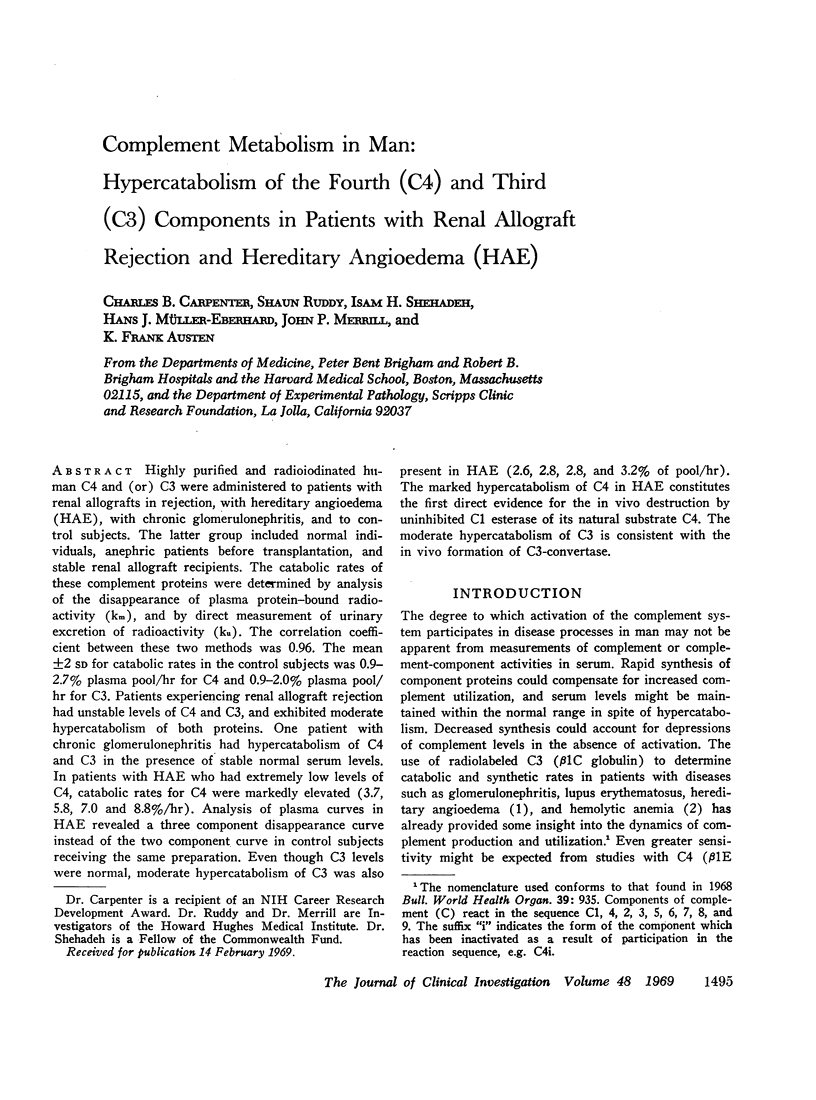
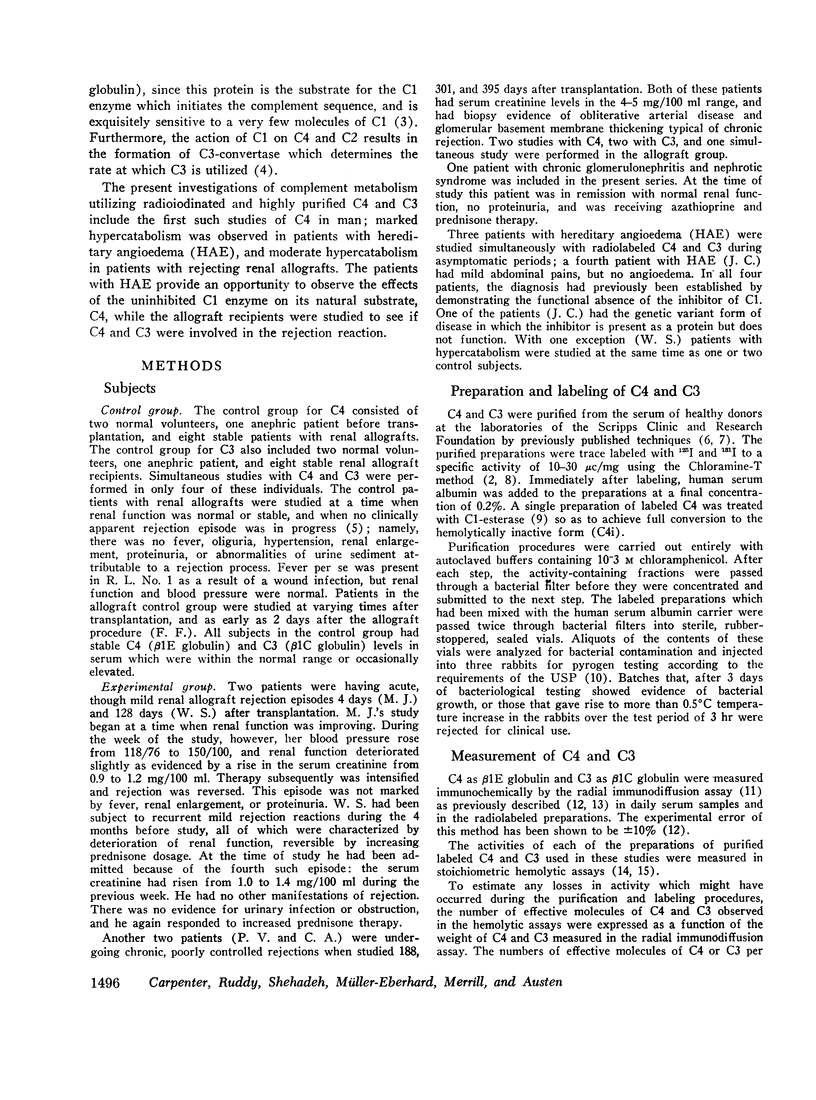
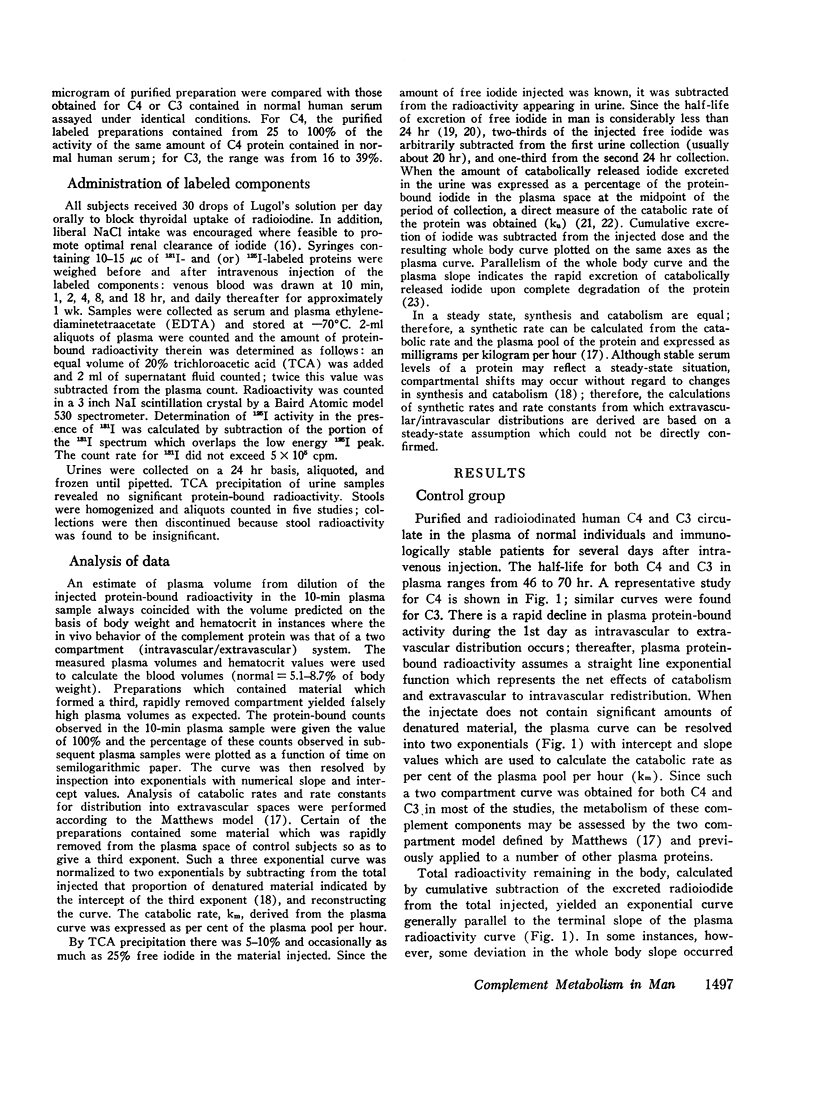

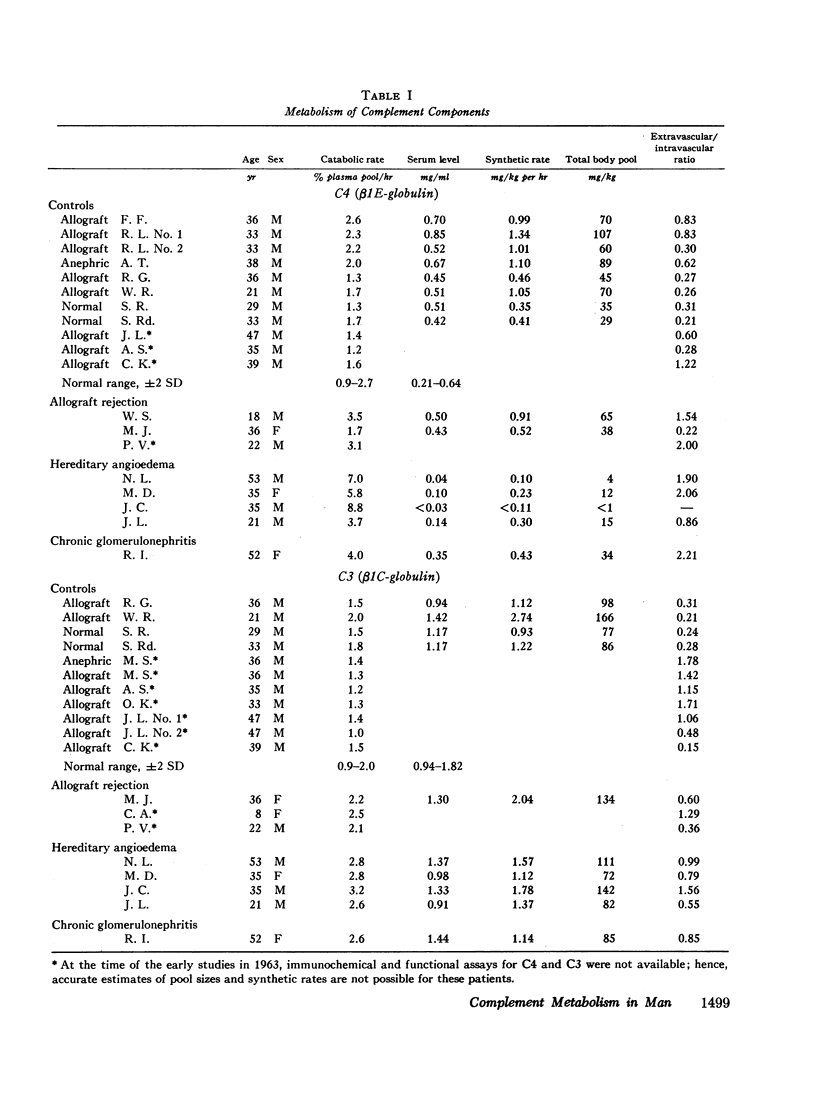
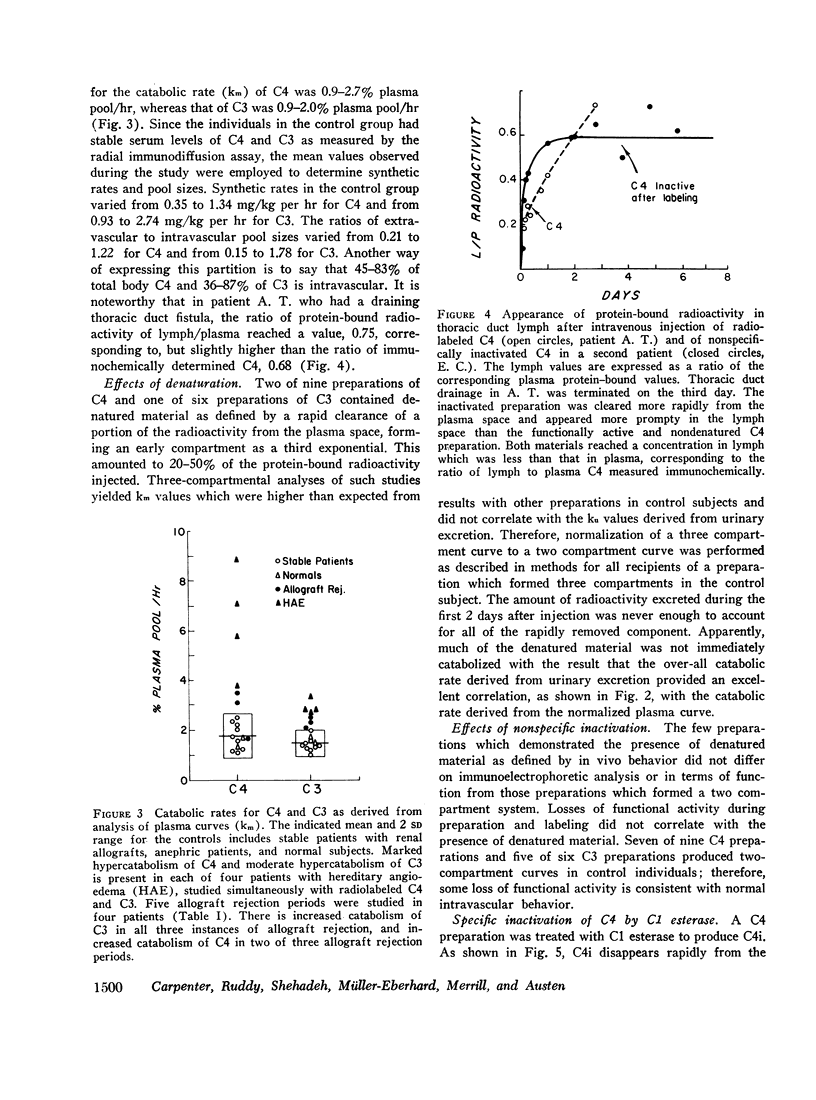
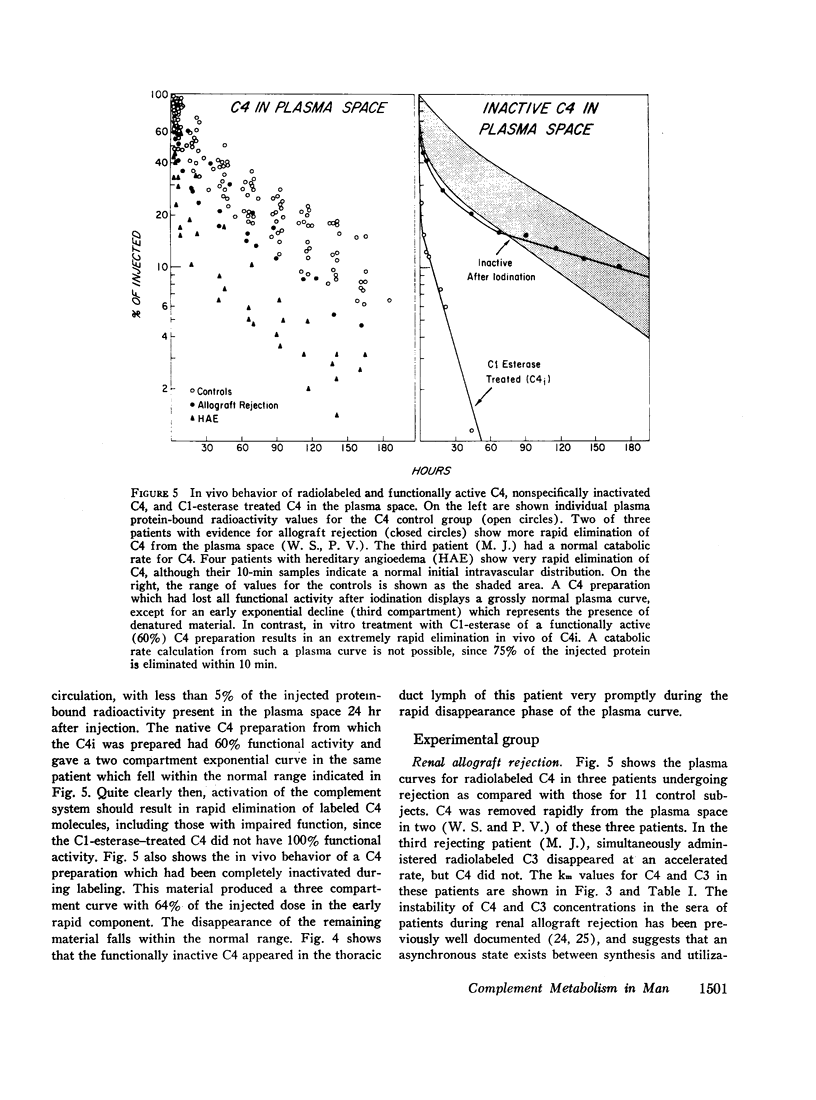
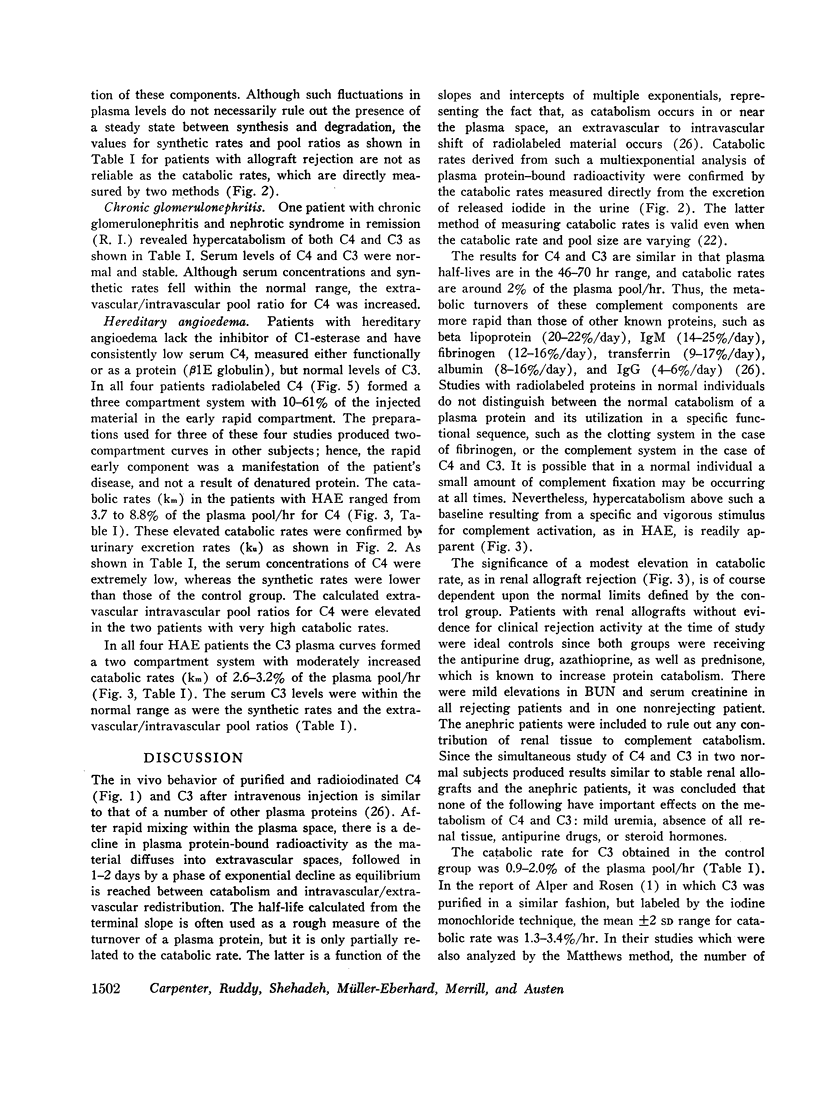
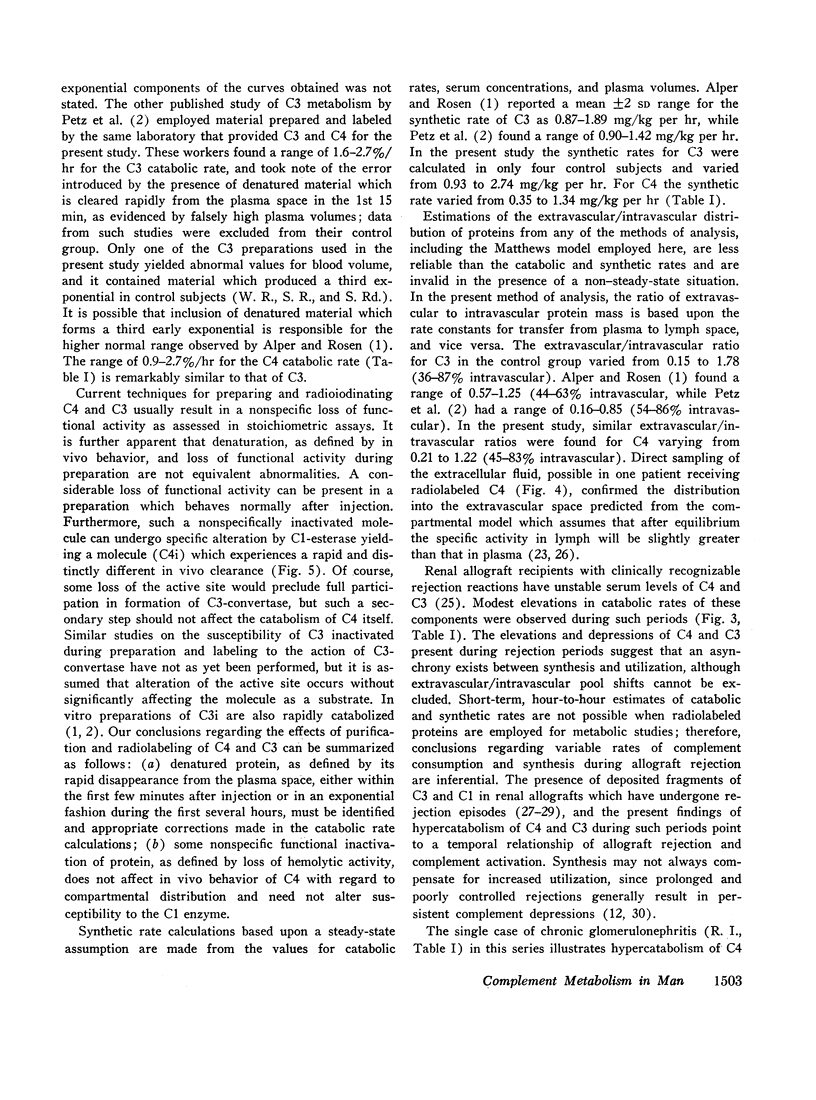


Images in this article
Selected References
These references are in PubMed. This may not be the complete list of references from this article.
- Alper C. A., Rosen F. S. Alper CA, Rosen FS: Studies of the in vivo behavior of human C'3 in normal subjects and patients. J Clin Invest. 1967 Dec;46(12):2021–2034. doi: 10.1172/JCI105691. [DOI] [PMC free article] [PubMed] [Google Scholar]
- BEEKEN W. L., VOLWILER W., GOLDSWORTHY P. D., GARBY L. E., REYNOLDS W. E., STOGSDILL R., STEMLER R. S. Studies of I-131-albumin catabolism and distribution in normal young male adults. J Clin Invest. 1962 Jun;41:1312–1333. doi: 10.1172/JCI104594. [DOI] [PMC free article] [PubMed] [Google Scholar]
- BERSON S. A., YALOW R. S., SCHREIBER S. S., POST J. Tracer experiments with I131 labeled human serum albumin: distribution and degradation studies. J Clin Invest. 1953 Aug;32(8):746–768. doi: 10.1172/JCI102789. [DOI] [PMC free article] [PubMed] [Google Scholar]
- Busch G. J., Braun W. E., Carpenter C. B., Corson J. M., Galvanek E. R., Reynolds E. S., Merrill J. P., Dammin G. J. Intravascular coagulation (IVC) in human renal allograft rejection. Transplant Proc. 1969 Mar;1(1):267–270. [PubMed] [Google Scholar]
- CAMPBELL R. M., CUTHBERTSON D. P., MATTHEWS C. M., MCFARLANE A. S. Behaviour of 14C- and 131I-labelled plasma proteins in the rat. Int J Appl Radiat Isot. 1956 Jul;1(1-2):66–84. doi: 10.1016/0020-708x(56)90020-5. [DOI] [PubMed] [Google Scholar]
- Carpenter C. B., Gill T. J., 3rd, Merrill J. P., Dammin G. J. Alterations in human serum beta-1C-gobulin (C'3) in renal transplantation. Am J Med. 1967 Dec;43(6):854–867. doi: 10.1016/0002-9343(67)90244-6. [DOI] [PubMed] [Google Scholar]
- Carpenter C. B., Ruddy S., Shehadeh I. H., Merrill J. P., Austen K. F., Muller-Eberhard H. J. Metabolism of radiolabelled C'3 and C'4 in human renal allograft recipients. Transplant Proc. 1969 Mar;1(1):279–282. [PubMed] [Google Scholar]
- DONALDSON V. H., ROSEN F. S. ACTION OF COMPLEMENT IN HEREDITARY ANGIONEUROTIC EDEMA: THE ROLE OF C'1-ESTERASE. J Clin Invest. 1964 Nov;43:2204–2213. doi: 10.1172/JCI105094. [DOI] [PMC free article] [PubMed] [Google Scholar]
- Gigli I., Austen K. F. Fluid phase destruction of C2hu by C1hu. I. Its enhancement and inhibition by homologous and heterologous C4. J Exp Med. 1969 Apr 1;129(4):679–696. doi: 10.1084/jem.129.4.679. [DOI] [PMC free article] [PubMed] [Google Scholar]
- Lindquist R. R., Guttmann R. D., Merrill J. P., Dammin G. J. Human renal allografts. Interpretation of morphologic and immunohistochemical observations. Am J Pathol. 1968 Nov;53(5):851–881. [PMC free article] [PubMed] [Google Scholar]
- MATTHEWS C. M. Effects of plasmapheresis on albumin pools in rabbits. J Clin Invest. 1961 Mar;40:603–610. doi: 10.1172/JCI104290. [DOI] [PMC free article] [PubMed] [Google Scholar]
- MATTHEWS C. M. The theory of tracer experiments with 131I-labelled plasma proteins. Phys Med Biol. 1957 Jul;2(1):36–53. doi: 10.1088/0031-9155/2/1/305. [DOI] [PubMed] [Google Scholar]
- MUELLER-EBERHARD H. J., BIRO C. E. ISOLATION AND DESCRIPTION OF THE FOURTH COMPONENT OF HUMAN COMPLEMENT. J Exp Med. 1963 Sep 1;118:447–466. doi: 10.1084/jem.118.3.447. [DOI] [PMC free article] [PubMed] [Google Scholar]
- MUELLER-EBERHARD H. J., LEPOW I. H. C'1 ESTERASE EFFECT ON ACTIVITY AND PHYSICOCHEMICAL PROPERTIES OF THE FOURTH COMPONENT OF COMPLEMENT. J Exp Med. 1965 May 1;121:819–833. doi: 10.1084/jem.121.5.819. [DOI] [PMC free article] [PubMed] [Google Scholar]
- McConahey P. J., Dixon F. J. A method of trace iodination of proteins for immunologic studies. Int Arch Allergy Appl Immunol. 1966;29(2):185–189. doi: 10.1159/000229699. [DOI] [PubMed] [Google Scholar]
- McFarlane A. S. IN VIVO BEHAVIOR OF I-FIBRINOGEN. J Clin Invest. 1963 Mar;42(3):346–361. doi: 10.1172/JCI104721. [DOI] [PMC free article] [PubMed] [Google Scholar]
- Müller-Eberhard H. J., Polley M. J., Calcott M. A. Formation and functional significance of a molecular complex derived from the second and the fourth component of human complement. J Exp Med. 1967 Feb 1;125(2):359–380. doi: 10.1084/jem.125.2.359. [DOI] [PMC free article] [PubMed] [Google Scholar]
- NILSSON U. R., MUELLER-EBERHARD H. J. ISOLATION OF BETA IF-GLOBULIN FROM HUMAN SERUM AND ITS CHARACTERIZATION AS THE FIFTH COMPONENT OF COMPLEMENT. J Exp Med. 1965 Aug 1;122:277–298. doi: 10.1084/jem.122.2.277. [DOI] [PMC free article] [PubMed] [Google Scholar]
- Petz L. D., Fink D. J., Letsky E. A., Fudenberg H. H., Müller-Eberhard J. In vivo metabolism of complement. I. Metabolism of the third component (C'3) in acquired hemolytic anemia. J Clin Invest. 1969 Nov;47(11):2469–2484. doi: 10.1172/JCI105929. [DOI] [PMC free article] [PubMed] [Google Scholar]
- Porter K. A., Andres G. A., Calder M. W., Dossetor J. B., Hsu K. C., Rendall J. M., Seegal B. C., Starzl T. E. Human renal transplants. II. Immunofluorescent and immunoferritin studies. Lab Invest. 1968 Feb;18(2):159–171. [PubMed] [Google Scholar]
- Ruddy S., Austen K. F. A stoichiometric assay for the fourth component of complement in whole human serum using EAC'la-gp and functionally pure human second component. J Immunol. 1967 Dec;99(6):1162–1172. [PubMed] [Google Scholar]
- Ruddy S., Austen K. F. C3 inactivator of man. I. Hemolytic measurement by the inactivation of cell-bound C3. J Immunol. 1969 Mar;102(3):533–543. [PubMed] [Google Scholar]
- TAKEDA Y., REEVE E. B. Distribution and excretion of I-131-iodide in men on pharmacologic doses of iodides. J Lab Clin Med. 1962 Dec;60:944–953. [PubMed] [Google Scholar]



